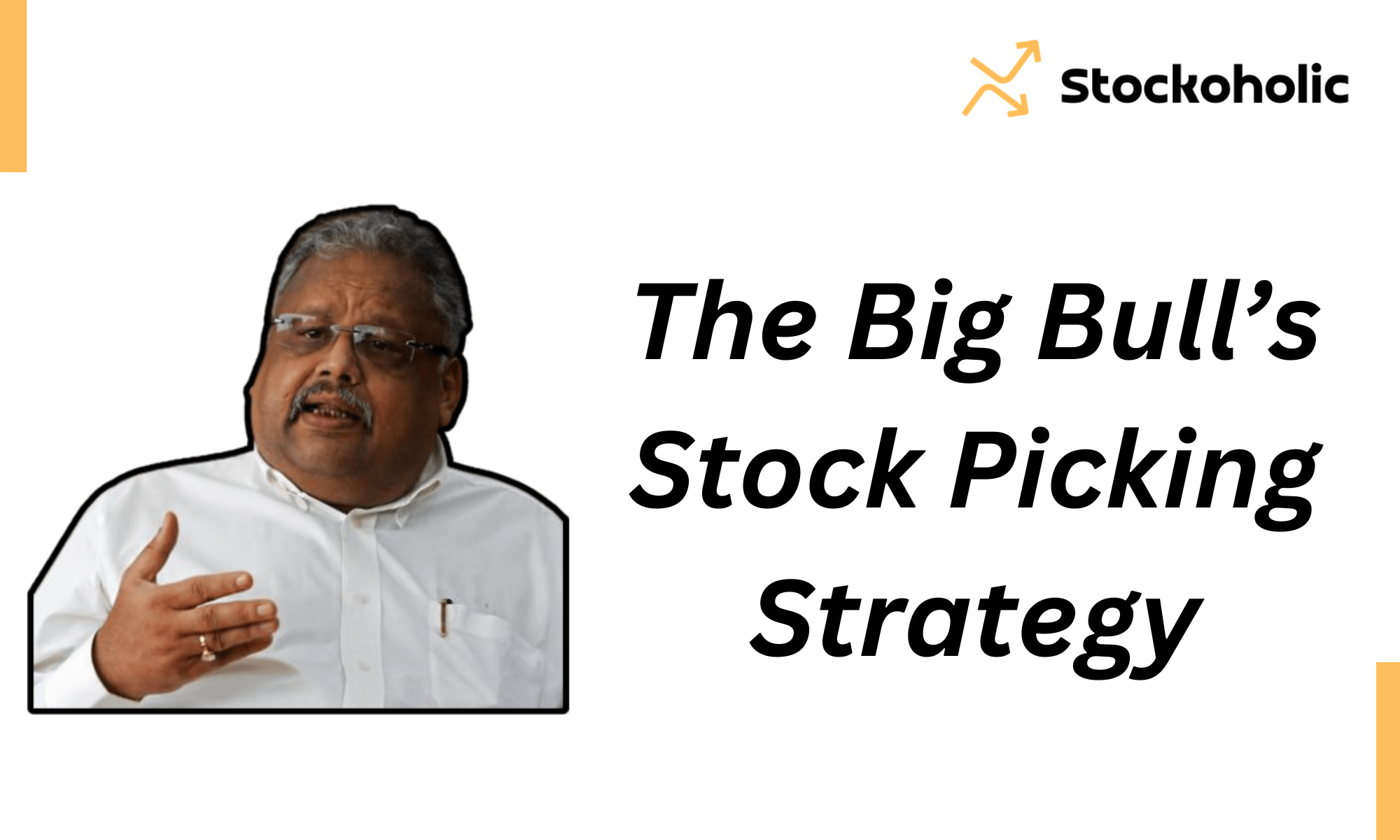Late Mr. Rakesh Jhunjhunwala, the “Big Bull” of the Indian stock market, was a legendary investor known for his investment decisions and remarkable success. In this blog, we will decode Rakesh Jhunjhunwala’s investing strategy, including his approach to market timing, portfolio composition, stock selection, and valuable advice for budding investors.
So, let’s get started:
Table of Contents
What was the investment strategy of Rakesh Jhunjhunwala?
The Big Bull has been an inspiration for all stock market enthusiasts. But who really knows the inside story of how Mr. Jhunjhunwala really invested? Let’s decode it…
1. Buy when the market is rising; sell when the market is falling
Rakesh Jhunjhunwala followed a momentum strategy, which means he tended to buy stocks when the market was rising and sell when it was falling. This strategy involves identifying trends and investing in the direction of those trends. By doing so, he aimed to leverage the upward or downward movement in stock prices rather than strictly adhering to the conventional “buy low, sell high” approach.
Let’s understand this concept:
Buy when the market is rising:
When the market is experiencing an upward trend or rising prices, it suggests positive sentiment among investors. Buying during a rising market is based on the expectation that the upward momentum will continue, allowing the investor to sell the stock later at a higher price.
Sell when the market is falling:
Conversely, when the market is in a downward trend or falling, it indicates negative sentiment and a potential decline in prices. Selling during a falling market is a strategy to minimize losses or, in some cases, profit from short selling (betting that the price will go down).
2. Invest in Companies with a strong Competitive Advantage
Rakesh Jhunjhunwala’s investment strategy revolved around choosing companies with a competitive advantage. A competitive advantage is something that sets a company apart from its competitors and gives it an edge in the market. This could be a unique product or service, cost efficiency, strong brand recognition, intellectual property, or any factor that makes the company more competitive.
Companies with a competitive edge are better positioned to withstand market fluctuations and competition, which can contribute to long-term success. They may be able to charge premium prices, maintain higher profit margins, and attract and retain customers more effectively than their competitors.
3. But at the Right Price
Rakesh Jhunjhunwala follows a strategy of purchasing stocks at the right price. He says, “It not only matters what you buy, but at what price you buy.” This principle highlights the idea that even a fundamentally strong stock may not be a wise investment if it is bought at an unfavorable price. Jhunjhunwala’s strategy involved a keen focus on entry points, ensuring that investments are made when market conditions and valuations offer a favorable price.
4. Buy in Milestones
Recognizing the uncertainty in the market, Mr. Jhunjhunwala avoided investing all his capital in one go. Instead, he adopted a cautious approach by initially purchasing a small quantity of stock, analyzing its performance, and then deciding whether to increase his investment. This strategy helped manage risk by allowing for adjustments based on the ongoing market conditions.
5. Different portfolios for trading and investing
Rakesh Jhunjhunwala followed a strategy of maintaining distinct portfolios for trading and investing. This means that he kept separate sets of investments for these two purposes.
For trading, the focus is often on short-term gains, and the portfolio may involve more frequent buying and selling of assets. On the other hand, the investing portfolio is geared towards long-term growth, and the holdings may be chosen with a view to holding them over an extended period.
By keeping these portfolios separate, Jhunjhunwala was able to manage risk and optimize his approach to the varying dynamics of short-term trading and long-term investing.
Rakesh Jhunjhunwala portfolio 2023
Rakesh Jhunjhunwala Investments tips
Here are some investment tips Mr. Jhunjhunwala shared in his interviews:
Don’t try to be an expert in everything
Rakesh Jhunjhunwala always emphasized that one doesn’t have to be an expert in everything when it comes to investing. He said, “We make decisions with informed ignorance.” Jhunjhunwala highlighted that even he, as an experienced investor, never claimed to know everything about each sector. The idea is to know that there are limitations to what an individual can know, and investors should make decisions with humility, being aware of what they don’t know.
Moreover, he pointed out that companies and management teams may not disclose everything, adding an additional layer of uncertainty. Therefore, the approach involves making informed decisions while acknowledging the inherent gaps in knowledge.
Learn from your mistakes.
Mr. Jhunjhunwala openly stated, “I’m not afraid of buying a wrong stock.” It means understanding that not every stock purchase will be successful, but each mistake can provide valuable lessons. He emphasizes that investors can only become great by learning from their wrong investments. Therefore, he encourages investors to embrace the learning process, make mistakes, but most importantly, avoid repeating them in order to grow and improve their investment strategies.
Advice for newbie: study the market and be passionate about it.
For newcomers in the investment world, Rakesh Jhunjhunwala offered a simple yet crucial piece of advice: study the market and be passionate about it. This guidance underscores the importance of acquiring a deep understanding of how the markets work.
By dedicating time to learning and staying passionate about the subject, new investors can build a solid foundation of knowledge. Jhunjhunwala’s emphasis on passion suggests that a genuine interest in the market can fuel the motivation needed for continuous learning and navigating the complexities of investing.
Understand Investors Sentiment
“Everything in the world affects the market because the market runs on investors’ emotions,” said Mr. Jhunjhunwala. He states that economic indicators, geopolitical developments, and various external factors can sway market dynamics. Investors’ emotions, such as fear, greed, optimism, and pessimism, can influence their buying and selling decisions, thereby affecting stock prices and market trends.
Investor sentiment often exhibits a herd mentality, where individuals follow the actions of the majority. If many investors are buying, others may feel compelled to buy as well, contributing to market trends. The same applies to selling during a bearish sentiment.
These emotional responses collectively contribute to the overall sentiment in the market.
Rakesh Jhunjhunwala’s Trading Advice
– Know how to book loss
When you invest or trade in the financial markets, there’s always a chance that you might incur losses. “Booking a loss” means accepting that a trade is not going in the desired direction and deciding to sell the investment at a loss. Jhunjhunwala suggests that experiencing losses is a crucial part of learning to trade. It teaches you to recognize when a trade is not going as planned and helps you avoid bigger losses in the future. It’s easy to become emotionally attached to an investment and hope that it will turn around. However, learning to book a loss helps traders avoid making emotional decisions and allows them to stay objective.
– Big money is made in big swings.
When Rakesh Jhunjhunwala said, “Big money is made in big swings,” he referred to the potential for substantial profits in the stock market when there are significant price movements. Here’s a breakdown in simple terms:
Big Swings: “Big swings” refers to large and significant price fluctuations in the stock market. This could mean substantial increases (upswings) or decreases (downswings) in the prices of stocks or other financial instruments.
Profit Opportunity: Jhunjhunwala is suggesting that there is an opportunity to make substantial profits when the market experiences these significant movements. Traders and investors who are able to identify and capitalize on these big swings can potentially earn significant returns on their investments.
Risk and Reward: While big swings offer the potential for significant profits, they also come with increased risk. Investors need to carefully analyze and manage the risks associated with such volatile movements in order to make informed decisions.
Timing and Strategy: Successfully navigating big swings requires good timing and a sound investment strategy. Investors need to be vigilant in monitoring market trends, news, and other factors that can influence prices. Having a well-thought-out strategy is crucial for capitalizing on these opportunities.
In summary, Jhunjhunwala highlighted the idea that substantial profits can be made when there are notable and pronounced movements in the market. However, it’s important to approach such opportunities with a clear strategy and an understanding of the associated risks.
Conclusion:
This was our Big Bull’s approach to investing. Which one are you adopting? Let us know in the comments below….
Researched by: Mahek Solanki




